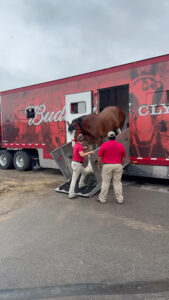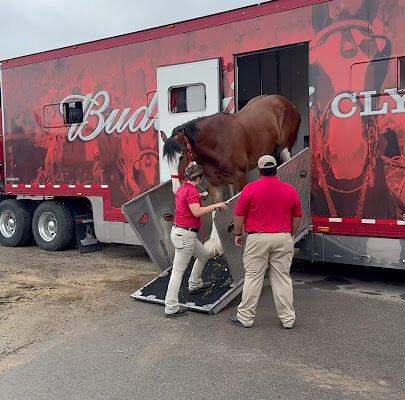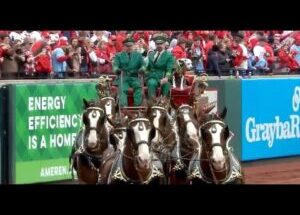
The early morning sky over Tomah, Wisconsin, is still faintly rosy when the unmistakable rumble of semi-tractor engines begins to echo across the fairgrounds. It is a moment of anticipation—an arrival that draws both respect and curiosity: the Budweiser Clydesdales are coming. For many fans gathered around the gates of the Budweiser Dairyland Super National Truck & Tractor Pull, this is more than spectacle—it is a tradition of power, grace, and iconic American imagery set in motion.
As the crimson and white trucks pull through the gates into Recreation Park, their presence commands attention. These aren’t ordinary haulers. The trailers bear bold branding — “Budweiser Clydesdales” emblazoned in crisp lettering, along with stately images of the horses in full harness. The ground vibrates gently beneath the weight of the rig, and spectators pause in their morning routines—vendors arranging booths, tractor teams prepping in the pits—to watch.
From inside each trailer come muffled sounds: the shifting of hooves, quiet snorts, the soft shuffle of bedding. The handlers—professional, calm, experienced—begin assembling at each trailer ramp. Each person is clad in Budweiser red and khaki: crisp shirts, sturdy boots, gloves for handling lines and hitching gear. Their movements are methodical, practiced, respectful.
Slowly, the ramp gates swing open. At first, only a foot or two of light drifts outward—sand or shavings placed at the ramp’s threshold to help the horses grip the surface. A single Clydesdale steps forward, tentative but confident. Its coat gleams in the dawn light, mane and tail brushed, white socks gleaming on its powerful legs. Each step is measured, calm. The handlers around it softly offer voices of encouragement, guiding it with halters and lead lines.
Behind it, others follow. One after another, the horses make their descent. In some trailers there are two levels; in others, a single row. The loading pattern had been planned long ago, to balance weight, ensure ventilation, and allow each horse a clear path forward. Now, as the ramp extends, the animals emerge into daylight, blinking, stretching necks, adjusting to the open air.
Spectators lean closer—some behind fences, others at a respectful distance—capturing the moment on phones or cameras. Children point, adults nod in admiration. The handlers move in smooth unison, leading each horse to the holding area. There is no rushing, only a composed procession.
The unloading is precise but not mechanical. The lead horse sets the tone with calm assurance. Others, some younger or more energetic, may shift slightly, glance at their surroundings, ears flicking. But their training shows: they respond to touch and voice, to gentle guiding reins and soft directional cues. The handlers remain alert—watchful for signs of nervousness, ready to adjust.
Once on solid ground, each horse is led by a handler to a temporary staging area. Here, between the trailers and the paddocks beyond, lies a zone of transition: shady lanes of fencing, water troughs, grooming stations. The setting smells faintly of hay and leather, clean wood shavings, and fresh morning air. The ground underfoot is firm dirt, turned here and there by foot traffic or previous events, but well tamped in many places to ease the horses’ steps.
Handlers lead the horses in pairs or singly to these staging stalls. Some are walked a few steps to stretch legs; others sniff curiously at their surroundings. Their coats may glisten with sweat from transport, so grooming begins immediately—brushes, rags, hoof picks. Quiet murmurs assuage any tension: gentle strokes along flanks, scrubbing of legs, checking for rubs or soreness. Saddlery and harnessing gear are staged nearby, polished and ready.
Nearby, crew members unload crates of feed, water buckets, grooming supplies, tack gear, and hay. Wagons emblazoned with Budweiser logos wait, ready for final hitching to the team of Clydesdales when their performance is due. The iconic red beer wagon will be hitched to these horses later, but now the focus is simply getting each animal off the trucks safely, calm, secure.
During this process, the energy in the fairgrounds shifts. Where earlier the tractor pull teams occupied all attention, now another draw emerges: the majestic horses themselves. People drift over, trying to see through fences, catch glimpses of the animals’ faces, hearing the metallic clinks as harness parts get laid out. Some take a quiet moment: a father points the horse’s hoof to a child; a photographer crouches to catch the contrast of white blaze on dark brown coat.
From time to time, a handler calls a quiet command: “Easy, boy.” “Step forward.” The voices are quiet but confident. They guide the animals with assurance. There is no whistle, no hurried shouting, just steady direction. The viewers feel the deliberateness. These horses are ambassadors—symbols of strength, dignity, and discipline.
As the final horses emerge from their trailers, the last ramp is lifted. The empty trailers stand open, awaiting further tasks or departure. The handlers perform a final sweep: checking for any left-behind equipment, ensuring all gates are locked, removing ramps carefully. The staging area becomes calmer. Horses, now fully on ground, begin relaxing—some chew slowly, some shift weight from one foot to another, some flick flies away with their tail.
By midmorning, the process is nearly complete. The Clydesdales are all unloaded, groomed, and settled into their temporary holding. The scene is now composed: rows of noble animals, their coats shining, white-feathered lower legs clean and free from debris, manes brushed, each assigned to a handler. A few grazing motions, some looking toward the arena, others facing the trucks.
In the background, the roar of tractor pulls begins to reach ears—a reminder of the main event. But for many, this moment of unloading was equally significant: witnessing the turning moment when power is transitioned from transport to presentation. The gentle giant horses are now ready for their moments in the spotlight.
Through the rest of the day, handlers continue caring for the horses: feeding, offering water, checking hooves, walking them gently to keep circulation strong, monitoring for signs of stress from the journey. And when showtime arrives, the horses will be expertly harnessed to the red wagon, their steps synchronizing, hoofbeats echoing across the ground, producing an unforgettable pageant of tradition and spectacle.
Additional reflections and context
To flesh out further, one might reflect on the legacy, the preparation, and the broader backdrop:
The Budweiser Clydesdales have been iconic ambassadors for Anheuser-Busch for over a century. Every appearance is carefully orchestrated by a traveling team of handlers who specialize in equine care, logistics, and public presentation. When arriving in Tomah for the 2025 Dairyland Super Nationals, they carry both the weight of tradition and the expectation of flawless spectacle. (On social media one caption read, “Unloading the Budweiser Clydesdales at the 2025 Tomah Tractor Pull!! #tomahtractorpull.”) YouTube+1
The event itself, the Budweiser Dairyland Super Nationals, is a highlight in the tractor pull circuit, bringing in the roar of mighty engines, the smell of diesel, and a throng of fans from across the region. Tomah Tractor Pull+1 The decision to include a Budweiser Clydesdales exhibition adds a layer of pageantry and tradition to the mechanical spectacle.
From a logistical point of view, hauling these draft horses is no small task. Specialized trailers with padded stalls and ventilation systems ensure the animals’ comfort during transport. The unloading procedure is rehearsed in advance—and practiced at every stop on a tour. The handler teams are trained to manage each animal calmly and confidently, minimizing stress and ensuring safety for both horses and humans.
As the Clydesdales descend the ramps, spectators get a rare behind-the-scenes glimpse into the care and precision required. Unlike a typical spectator exhibit, seeing the moment of unloading gives insight into how much preparation, respect, and animal welfare go into these appearances. The horses are not simply icons—they are living, breathing creatures that require careful handling.
Emotionally, the scene evokes a contrast: the raw power of diesel tractors and modified rigs on one side, and the graceful, muscular strength of the Clydesdales on the other. The latter arrive not with noise and thunder, but with deliberate steps, quiet snorts, the gentle clink of harness hardware, and the soft murmurs of handlers. That contrast deepens the experience: machinery and mammal, horsepower and horse.
By the time the tractors begin their pulls, the Clydesdales already serve as living heralds — a promise that history, tradition, strength, and elegance live at this event. For many attendees, the highlight of seeing them unloaded and prepared becomes as memorable as the pulling competition itself.
If you like, I can revise this into a more journalistic-style article, or adapt it for a brochure or social media post (shorter, punchier). Would you like me to do that?

